Environmental Impact of Clothing Industry and UK Government Policies
VerifiedAdded on 2023/01/18
|7
|1516
|39
Report
AI Summary
This report investigates the significant environmental impact of the clothing industry, highlighting the negative consequences of textile production, including greenhouse gas emissions, water pollution from dyes, and deforestation due to fabric sourcing. It examines the shift towards sustainable practices driven by changing consumer preferences and governmental regulations. The report details the UK government's policies, such as the Climate Change Act and the Environmental Protection Act, aimed at reducing the industry's environmental footprint and promoting resource productivity. It also critiques the effectiveness of these policies and suggests the need for stricter enforcement and eco-friendly regulations. Furthermore, the report interprets data illustrating the environmental damage caused by various fabrics and emphasizes the importance of adopting sustainable raw materials and practices to minimize harm to both the environment and human health. The conclusion stresses the need for industry-wide sustainability and adherence to UK government regulations to mitigate the negative impacts of clothing production.
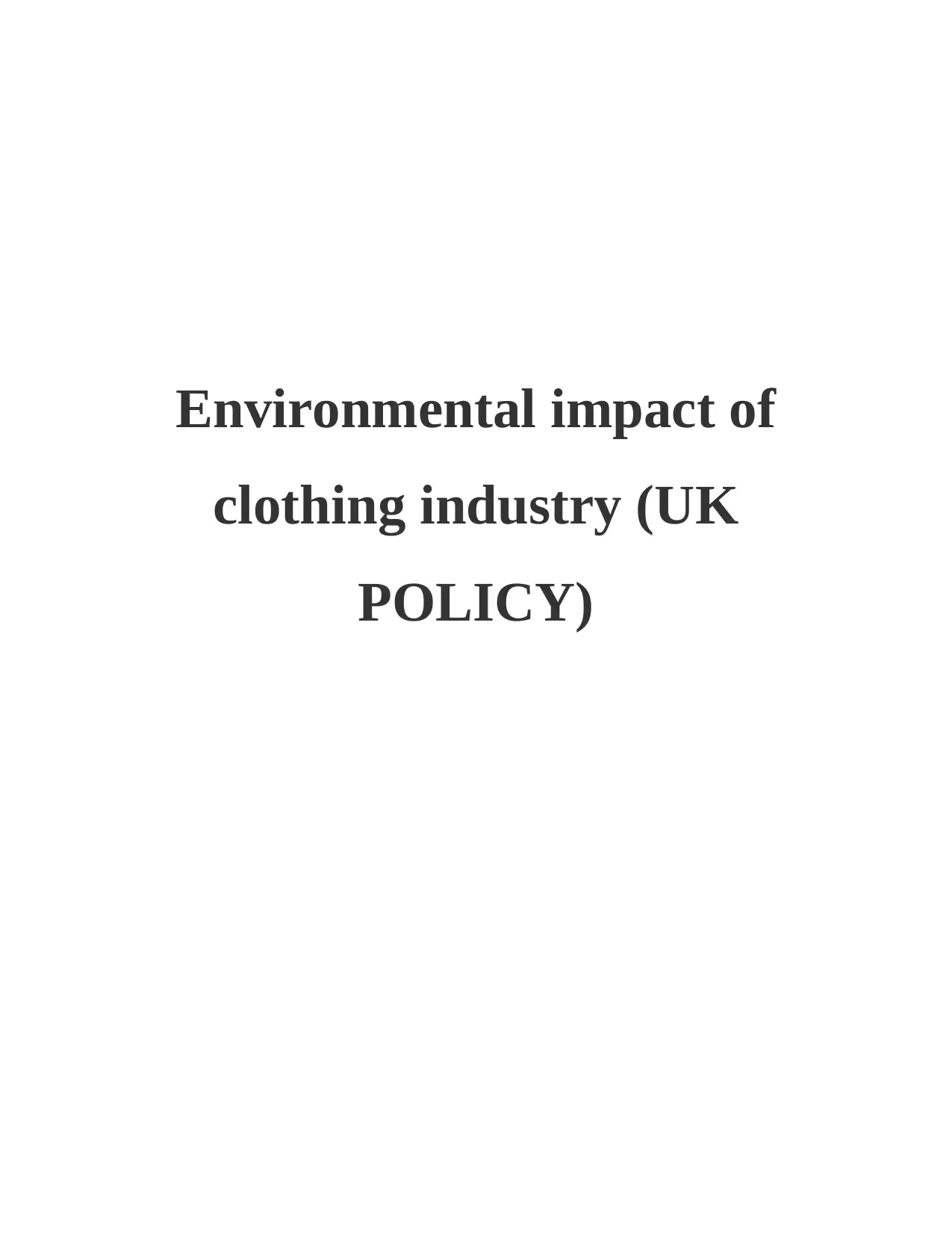
Environmental impact of
clothing industry (UK
POLICY)
clothing industry (UK
POLICY)
Paraphrase This Document
Need a fresh take? Get an instant paraphrase of this document with our AI Paraphraser

TABLE OF CONTENTS
INTRODUCTION...........................................................................................................................3
MAIN BODY...................................................................................................................................3
Theme 1:- Environmental impact of the clothing industry..........................................................3
Theme 2:- Policies set by UK government for clothing industry................................................4
CONCLUSION................................................................................................................................6
REFERENCES................................................................................................................................1
INTRODUCTION...........................................................................................................................3
MAIN BODY...................................................................................................................................3
Theme 1:- Environmental impact of the clothing industry..........................................................3
Theme 2:- Policies set by UK government for clothing industry................................................4
CONCLUSION................................................................................................................................6
REFERENCES................................................................................................................................1
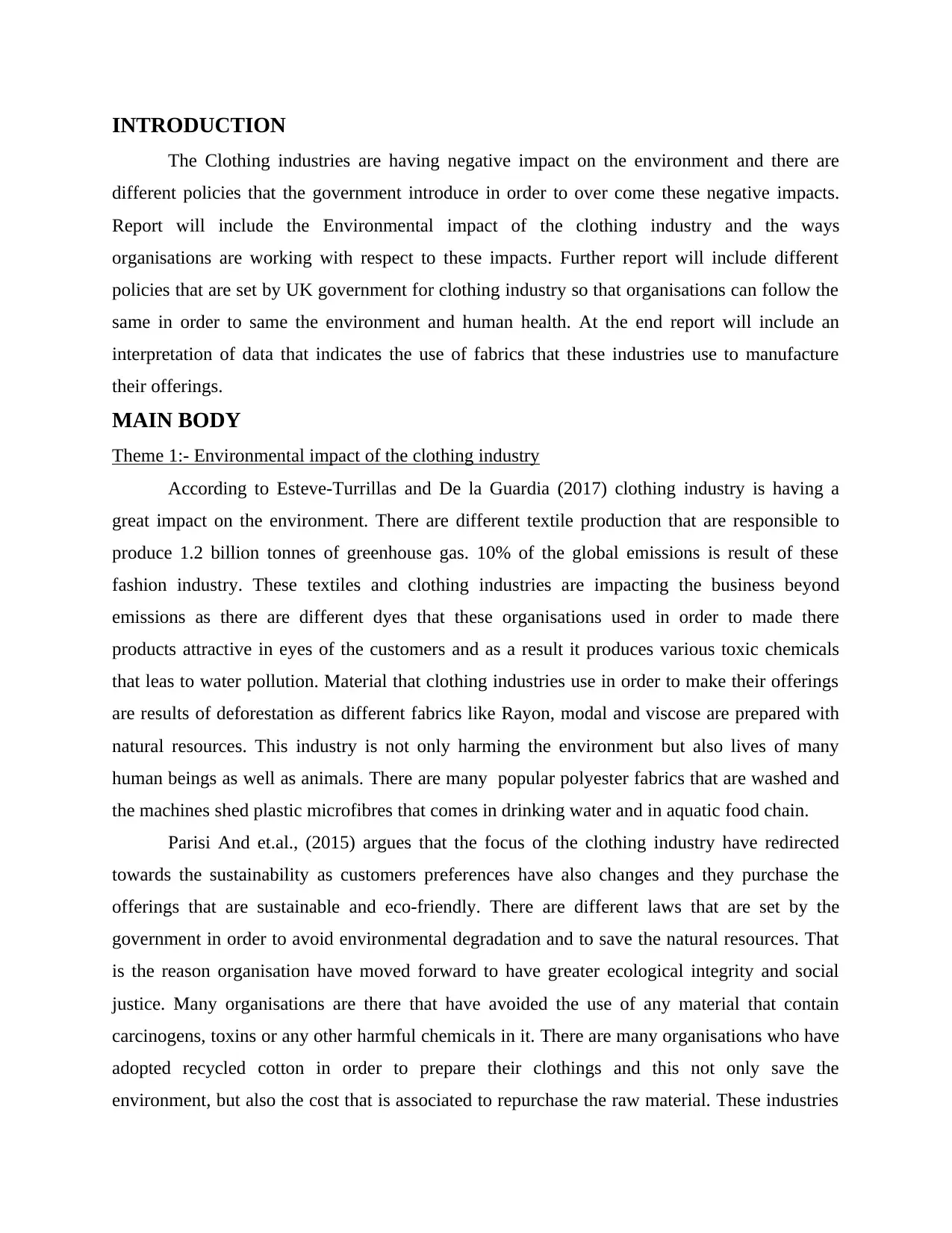
INTRODUCTION
The Clothing industries are having negative impact on the environment and there are
different policies that the government introduce in order to over come these negative impacts.
Report will include the Environmental impact of the clothing industry and the ways
organisations are working with respect to these impacts. Further report will include different
policies that are set by UK government for clothing industry so that organisations can follow the
same in order to same the environment and human health. At the end report will include an
interpretation of data that indicates the use of fabrics that these industries use to manufacture
their offerings.
MAIN BODY
Theme 1:- Environmental impact of the clothing industry
According to Esteve-Turrillas and De la Guardia (2017) clothing industry is having a
great impact on the environment. There are different textile production that are responsible to
produce 1.2 billion tonnes of greenhouse gas. 10% of the global emissions is result of these
fashion industry. These textiles and clothing industries are impacting the business beyond
emissions as there are different dyes that these organisations used in order to made there
products attractive in eyes of the customers and as a result it produces various toxic chemicals
that leas to water pollution. Material that clothing industries use in order to make their offerings
are results of deforestation as different fabrics like Rayon, modal and viscose are prepared with
natural resources. This industry is not only harming the environment but also lives of many
human beings as well as animals. There are many popular polyester fabrics that are washed and
the machines shed plastic microfibres that comes in drinking water and in aquatic food chain.
Parisi And et.al., (2015) argues that the focus of the clothing industry have redirected
towards the sustainability as customers preferences have also changes and they purchase the
offerings that are sustainable and eco-friendly. There are different laws that are set by the
government in order to avoid environmental degradation and to save the natural resources. That
is the reason organisation have moved forward to have greater ecological integrity and social
justice. Many organisations are there that have avoided the use of any material that contain
carcinogens, toxins or any other harmful chemicals in it. There are many organisations who have
adopted recycled cotton in order to prepare their clothings and this not only save the
environment, but also the cost that is associated to repurchase the raw material. These industries
The Clothing industries are having negative impact on the environment and there are
different policies that the government introduce in order to over come these negative impacts.
Report will include the Environmental impact of the clothing industry and the ways
organisations are working with respect to these impacts. Further report will include different
policies that are set by UK government for clothing industry so that organisations can follow the
same in order to same the environment and human health. At the end report will include an
interpretation of data that indicates the use of fabrics that these industries use to manufacture
their offerings.
MAIN BODY
Theme 1:- Environmental impact of the clothing industry
According to Esteve-Turrillas and De la Guardia (2017) clothing industry is having a
great impact on the environment. There are different textile production that are responsible to
produce 1.2 billion tonnes of greenhouse gas. 10% of the global emissions is result of these
fashion industry. These textiles and clothing industries are impacting the business beyond
emissions as there are different dyes that these organisations used in order to made there
products attractive in eyes of the customers and as a result it produces various toxic chemicals
that leas to water pollution. Material that clothing industries use in order to make their offerings
are results of deforestation as different fabrics like Rayon, modal and viscose are prepared with
natural resources. This industry is not only harming the environment but also lives of many
human beings as well as animals. There are many popular polyester fabrics that are washed and
the machines shed plastic microfibres that comes in drinking water and in aquatic food chain.
Parisi And et.al., (2015) argues that the focus of the clothing industry have redirected
towards the sustainability as customers preferences have also changes and they purchase the
offerings that are sustainable and eco-friendly. There are different laws that are set by the
government in order to avoid environmental degradation and to save the natural resources. That
is the reason organisation have moved forward to have greater ecological integrity and social
justice. Many organisations are there that have avoided the use of any material that contain
carcinogens, toxins or any other harmful chemicals in it. There are many organisations who have
adopted recycled cotton in order to prepare their clothings and this not only save the
environment, but also the cost that is associated to repurchase the raw material. These industries
⊘ This is a preview!⊘
Do you want full access?
Subscribe today to unlock all pages.

Trusted by 1+ million students worldwide
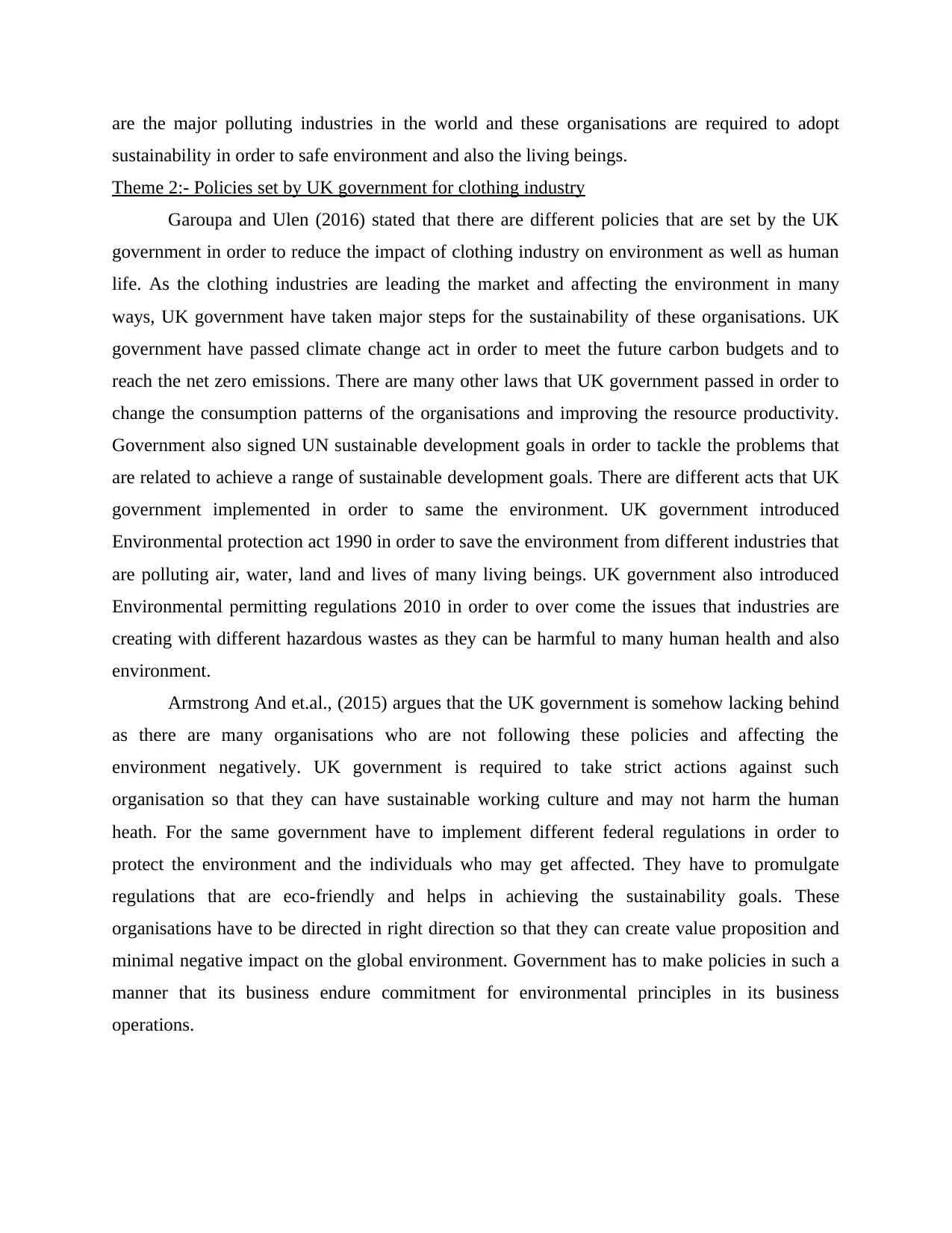
are the major polluting industries in the world and these organisations are required to adopt
sustainability in order to safe environment and also the living beings.
Theme 2:- Policies set by UK government for clothing industry
Garoupa and Ulen (2016) stated that there are different policies that are set by the UK
government in order to reduce the impact of clothing industry on environment as well as human
life. As the clothing industries are leading the market and affecting the environment in many
ways, UK government have taken major steps for the sustainability of these organisations. UK
government have passed climate change act in order to meet the future carbon budgets and to
reach the net zero emissions. There are many other laws that UK government passed in order to
change the consumption patterns of the organisations and improving the resource productivity.
Government also signed UN sustainable development goals in order to tackle the problems that
are related to achieve a range of sustainable development goals. There are different acts that UK
government implemented in order to same the environment. UK government introduced
Environmental protection act 1990 in order to save the environment from different industries that
are polluting air, water, land and lives of many living beings. UK government also introduced
Environmental permitting regulations 2010 in order to over come the issues that industries are
creating with different hazardous wastes as they can be harmful to many human health and also
environment.
Armstrong And et.al., (2015) argues that the UK government is somehow lacking behind
as there are many organisations who are not following these policies and affecting the
environment negatively. UK government is required to take strict actions against such
organisation so that they can have sustainable working culture and may not harm the human
heath. For the same government have to implement different federal regulations in order to
protect the environment and the individuals who may get affected. They have to promulgate
regulations that are eco-friendly and helps in achieving the sustainability goals. These
organisations have to be directed in right direction so that they can create value proposition and
minimal negative impact on the global environment. Government has to make policies in such a
manner that its business endure commitment for environmental principles in its business
operations.
sustainability in order to safe environment and also the living beings.
Theme 2:- Policies set by UK government for clothing industry
Garoupa and Ulen (2016) stated that there are different policies that are set by the UK
government in order to reduce the impact of clothing industry on environment as well as human
life. As the clothing industries are leading the market and affecting the environment in many
ways, UK government have taken major steps for the sustainability of these organisations. UK
government have passed climate change act in order to meet the future carbon budgets and to
reach the net zero emissions. There are many other laws that UK government passed in order to
change the consumption patterns of the organisations and improving the resource productivity.
Government also signed UN sustainable development goals in order to tackle the problems that
are related to achieve a range of sustainable development goals. There are different acts that UK
government implemented in order to same the environment. UK government introduced
Environmental protection act 1990 in order to save the environment from different industries that
are polluting air, water, land and lives of many living beings. UK government also introduced
Environmental permitting regulations 2010 in order to over come the issues that industries are
creating with different hazardous wastes as they can be harmful to many human health and also
environment.
Armstrong And et.al., (2015) argues that the UK government is somehow lacking behind
as there are many organisations who are not following these policies and affecting the
environment negatively. UK government is required to take strict actions against such
organisation so that they can have sustainable working culture and may not harm the human
heath. For the same government have to implement different federal regulations in order to
protect the environment and the individuals who may get affected. They have to promulgate
regulations that are eco-friendly and helps in achieving the sustainability goals. These
organisations have to be directed in right direction so that they can create value proposition and
minimal negative impact on the global environment. Government has to make policies in such a
manner that its business endure commitment for environmental principles in its business
operations.
Paraphrase This Document
Need a fresh take? Get an instant paraphrase of this document with our AI Paraphraser
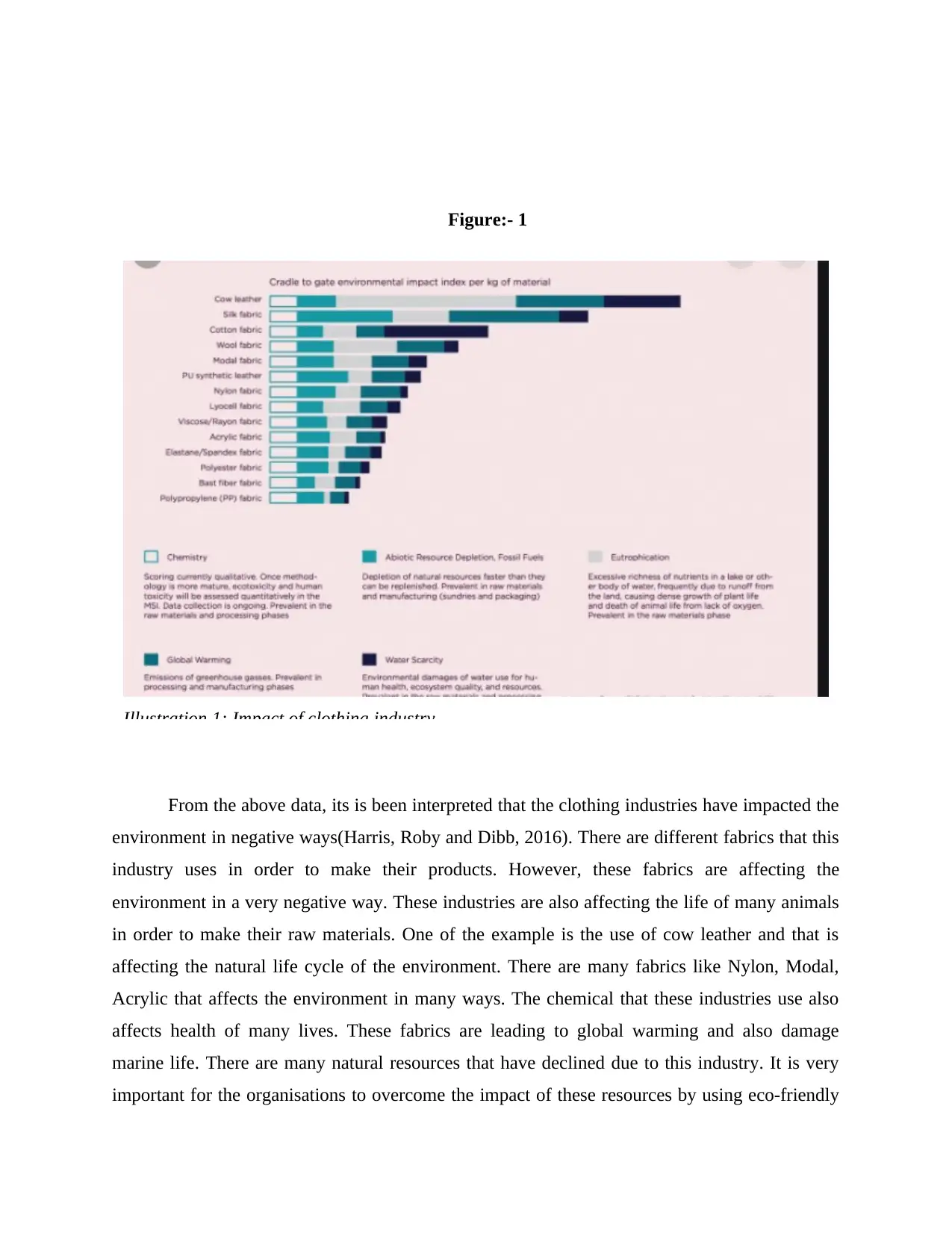
Figure:- 1
From the above data, its is been interpreted that the clothing industries have impacted the
environment in negative ways(Harris, Roby and Dibb, 2016). There are different fabrics that this
industry uses in order to make their products. However, these fabrics are affecting the
environment in a very negative way. These industries are also affecting the life of many animals
in order to make their raw materials. One of the example is the use of cow leather and that is
affecting the natural life cycle of the environment. There are many fabrics like Nylon, Modal,
Acrylic that affects the environment in many ways. The chemical that these industries use also
affects health of many lives. These fabrics are leading to global warming and also damage
marine life. There are many natural resources that have declined due to this industry. It is very
important for the organisations to overcome the impact of these resources by using eco-friendly
Illustration 1: Impact of clothing industry
From the above data, its is been interpreted that the clothing industries have impacted the
environment in negative ways(Harris, Roby and Dibb, 2016). There are different fabrics that this
industry uses in order to make their products. However, these fabrics are affecting the
environment in a very negative way. These industries are also affecting the life of many animals
in order to make their raw materials. One of the example is the use of cow leather and that is
affecting the natural life cycle of the environment. There are many fabrics like Nylon, Modal,
Acrylic that affects the environment in many ways. The chemical that these industries use also
affects health of many lives. These fabrics are leading to global warming and also damage
marine life. There are many natural resources that have declined due to this industry. It is very
important for the organisations to overcome the impact of these resources by using eco-friendly
Illustration 1: Impact of clothing industry
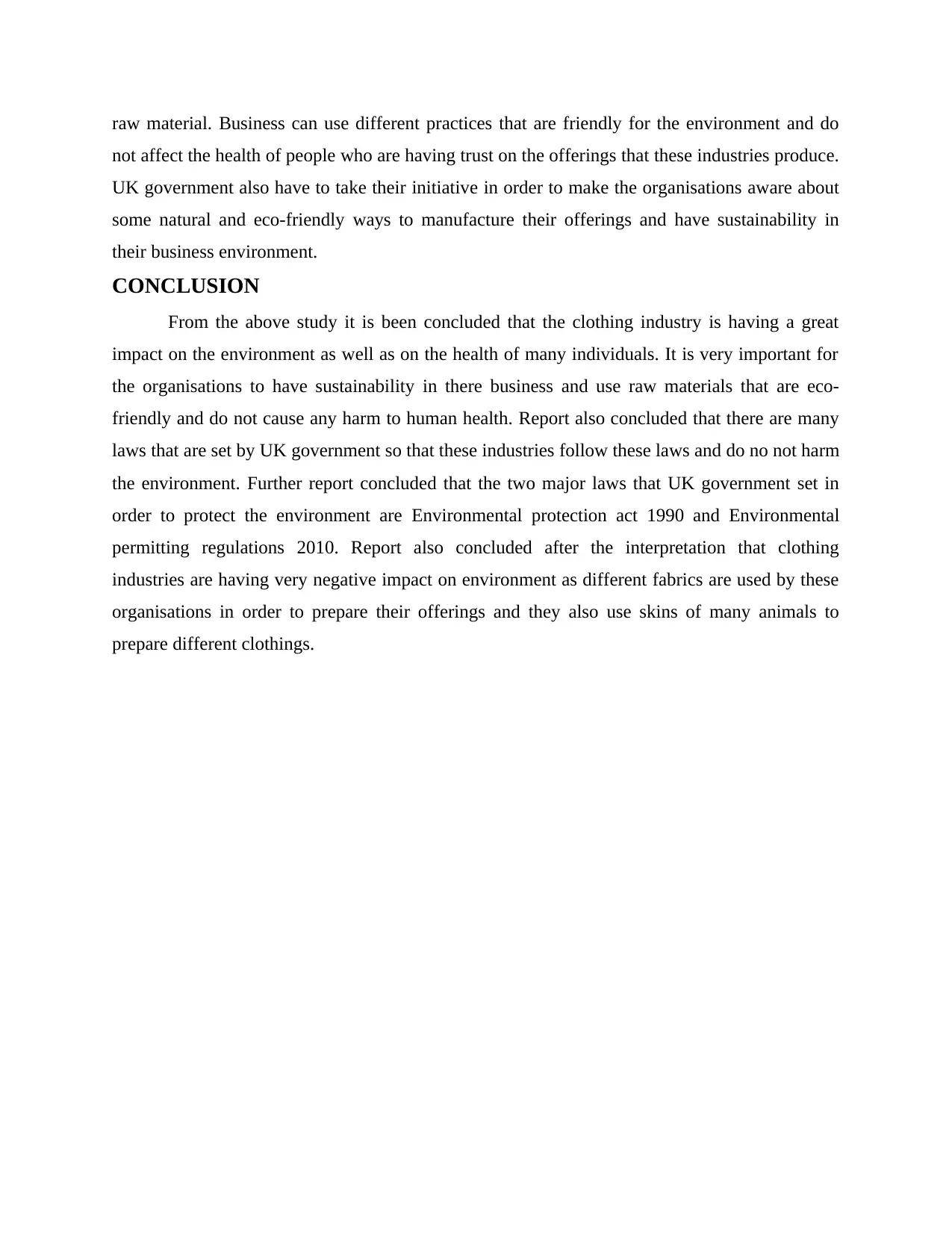
raw material. Business can use different practices that are friendly for the environment and do
not affect the health of people who are having trust on the offerings that these industries produce.
UK government also have to take their initiative in order to make the organisations aware about
some natural and eco-friendly ways to manufacture their offerings and have sustainability in
their business environment.
CONCLUSION
From the above study it is been concluded that the clothing industry is having a great
impact on the environment as well as on the health of many individuals. It is very important for
the organisations to have sustainability in there business and use raw materials that are eco-
friendly and do not cause any harm to human health. Report also concluded that there are many
laws that are set by UK government so that these industries follow these laws and do no not harm
the environment. Further report concluded that the two major laws that UK government set in
order to protect the environment are Environmental protection act 1990 and Environmental
permitting regulations 2010. Report also concluded after the interpretation that clothing
industries are having very negative impact on environment as different fabrics are used by these
organisations in order to prepare their offerings and they also use skins of many animals to
prepare different clothings.
not affect the health of people who are having trust on the offerings that these industries produce.
UK government also have to take their initiative in order to make the organisations aware about
some natural and eco-friendly ways to manufacture their offerings and have sustainability in
their business environment.
CONCLUSION
From the above study it is been concluded that the clothing industry is having a great
impact on the environment as well as on the health of many individuals. It is very important for
the organisations to have sustainability in there business and use raw materials that are eco-
friendly and do not cause any harm to human health. Report also concluded that there are many
laws that are set by UK government so that these industries follow these laws and do no not harm
the environment. Further report concluded that the two major laws that UK government set in
order to protect the environment are Environmental protection act 1990 and Environmental
permitting regulations 2010. Report also concluded after the interpretation that clothing
industries are having very negative impact on environment as different fabrics are used by these
organisations in order to prepare their offerings and they also use skins of many animals to
prepare different clothings.
⊘ This is a preview!⊘
Do you want full access?
Subscribe today to unlock all pages.

Trusted by 1+ million students worldwide
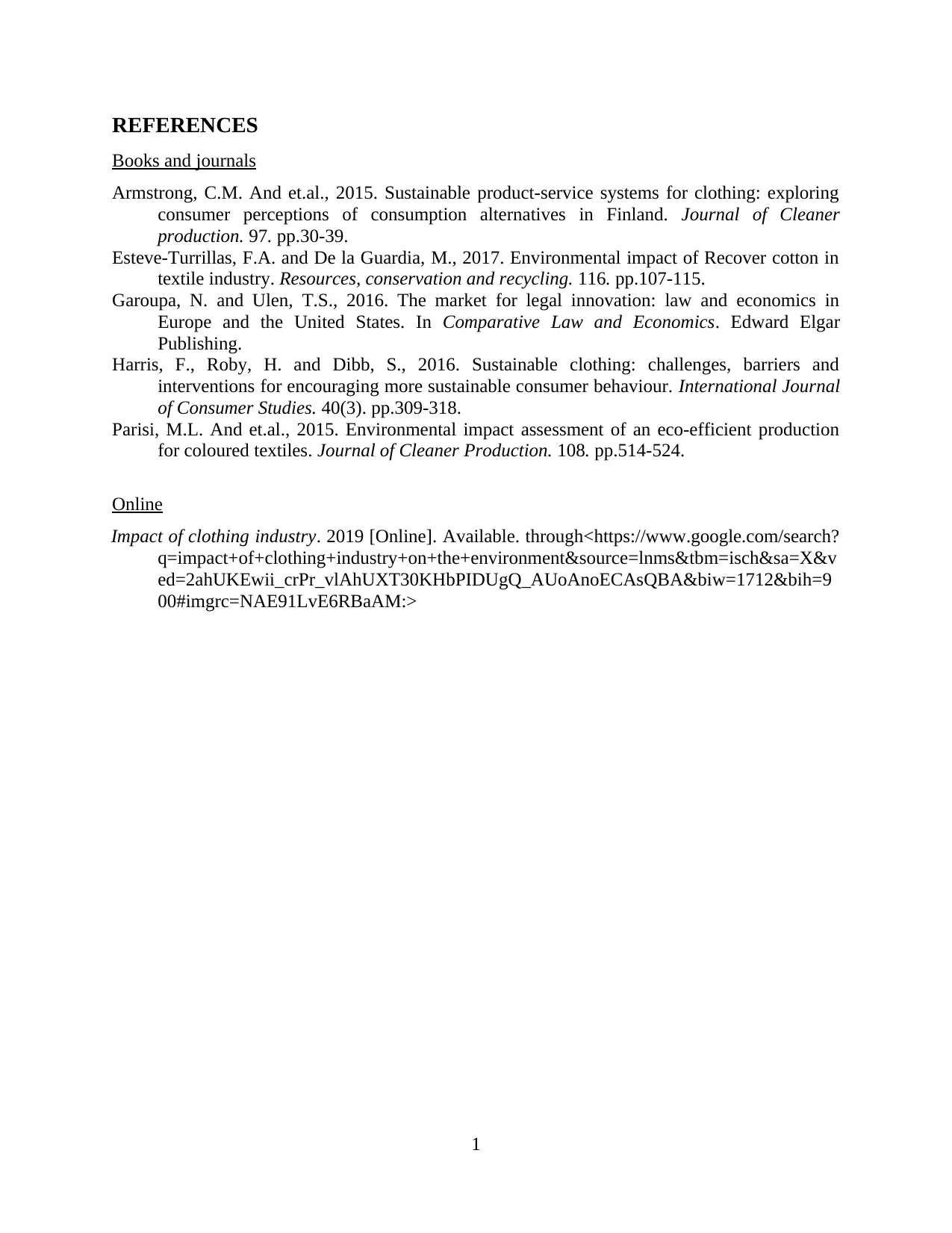
REFERENCES
Books and journals
Armstrong, C.M. And et.al., 2015. Sustainable product-service systems for clothing: exploring
consumer perceptions of consumption alternatives in Finland. Journal of Cleaner
production. 97. pp.30-39.
Esteve-Turrillas, F.A. and De la Guardia, M., 2017. Environmental impact of Recover cotton in
textile industry. Resources, conservation and recycling. 116. pp.107-115.
Garoupa, N. and Ulen, T.S., 2016. The market for legal innovation: law and economics in
Europe and the United States. In Comparative Law and Economics. Edward Elgar
Publishing.
Harris, F., Roby, H. and Dibb, S., 2016. Sustainable clothing: challenges, barriers and
interventions for encouraging more sustainable consumer behaviour. International Journal
of Consumer Studies. 40(3). pp.309-318.
Parisi, M.L. And et.al., 2015. Environmental impact assessment of an eco-efficient production
for coloured textiles. Journal of Cleaner Production. 108. pp.514-524.
Online
Impact of clothing industry. 2019 [Online]. Available. through<https://www.google.com/search?
q=impact+of+clothing+industry+on+the+environment&source=lnms&tbm=isch&sa=X&v
ed=2ahUKEwii_crPr_vlAhUXT30KHbPIDUgQ_AUoAnoECAsQBA&biw=1712&bih=9
00#imgrc=NAE91LvE6RBaAM:>
1
Books and journals
Armstrong, C.M. And et.al., 2015. Sustainable product-service systems for clothing: exploring
consumer perceptions of consumption alternatives in Finland. Journal of Cleaner
production. 97. pp.30-39.
Esteve-Turrillas, F.A. and De la Guardia, M., 2017. Environmental impact of Recover cotton in
textile industry. Resources, conservation and recycling. 116. pp.107-115.
Garoupa, N. and Ulen, T.S., 2016. The market for legal innovation: law and economics in
Europe and the United States. In Comparative Law and Economics. Edward Elgar
Publishing.
Harris, F., Roby, H. and Dibb, S., 2016. Sustainable clothing: challenges, barriers and
interventions for encouraging more sustainable consumer behaviour. International Journal
of Consumer Studies. 40(3). pp.309-318.
Parisi, M.L. And et.al., 2015. Environmental impact assessment of an eco-efficient production
for coloured textiles. Journal of Cleaner Production. 108. pp.514-524.
Online
Impact of clothing industry. 2019 [Online]. Available. through<https://www.google.com/search?
q=impact+of+clothing+industry+on+the+environment&source=lnms&tbm=isch&sa=X&v
ed=2ahUKEwii_crPr_vlAhUXT30KHbPIDUgQ_AUoAnoECAsQBA&biw=1712&bih=9
00#imgrc=NAE91LvE6RBaAM:>
1
1 out of 7
Related Documents
Your All-in-One AI-Powered Toolkit for Academic Success.
+13062052269
info@desklib.com
Available 24*7 on WhatsApp / Email
![[object Object]](/_next/static/media/star-bottom.7253800d.svg)
Unlock your academic potential
Copyright © 2020–2026 A2Z Services. All Rights Reserved. Developed and managed by ZUCOL.





